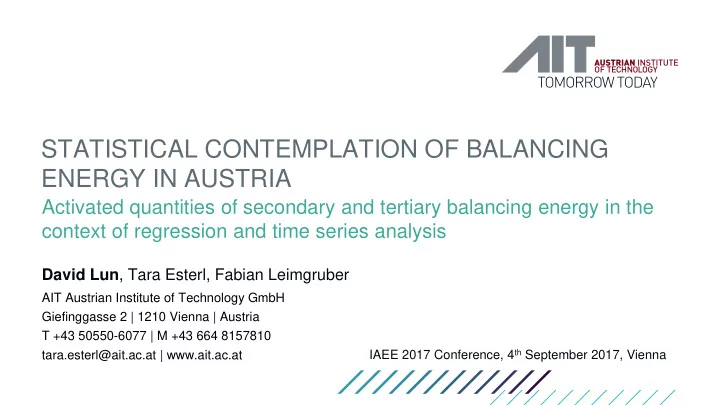

STATISTICAL CONTEMPLATION OF BALANCING ENERGY IN AUSTRIA Activated quantities of secondary and tertiary balancing energy in the context of regression and time series analysis David Lun , Tara Esterl, Fabian Leimgruber AIT Austrian Institute of Technology GmbH Giefinggasse 2 | 1210 Vienna | Austria T +43 50550-6077 | M +43 664 8157810 IAEE 2017 Conference, 4 th September 2017, Vienna tara.esterl@ait.ac.at | www.ait.ac.at
RESEARCH QUESTIONS & METHODS Research questions Methods • Which factors influence the released • Linear Regression quantities of positive and negative balancing • Tobit Model energy in Austria? • SARIMA • Compilation and evaluation of intraday- forecasts of positive and negative balancing • Weighted k-Nearest Neighbour energy. Regression 04/09/2017 2
SUMMARY I. Brief introduction to balancing energy II. Examining the time series III. Influence of exogenous factors and forecast 04/09/2017 3
WHAT IS BALANCING ENERGY? • Electricity grid connects producers and consumers – electricity can‘t be stored in the grid • Amount of extracted electricity has to equal supply for a functioning grid • Indicator: Net frequency – target: 50Hz • Supply ≠ demand → stability of grid endangered • Balancing energy compensates fluctuations Primary Secondary Tertiary I II III 04/09/2017 4
HOW DOES BALANCING ENERGY WORK? • There can be too much or too little electricity supplied to a grid • Further distinction Positive balancing energy Negative balancing energy • Balancing energy is organized by the TSO, supplied by producers of the electricity market • Static provision of power for a specified time frame • Strict requirements for participants of the market for balancing energy I II III 04/09/2017 5
SUMMARY I. Brief introduction to balancing energy II. Examining the time series III. Influence of exogenous factors and forecast 04/09/2017 6
SUPPLIED QUANTITY OF POSITIVE BALANCING ENERGY IN 2015 • Quantitiy supplied refers to aggregated amount of secondary and tertiary control reserves • Time series with ¼-hourly resolution and non-negative values • Observations from 2015 • Fixed boundaries (quantities contracted) Presentation: Examination reduced to positive balancing energy I II III 04/09/2017 7
AUTOCORRELATION OF SUPPLIED QUANTITY OF POSITIVE BALANCING ENERGY • High dependency on past realizations • Peaks at multiplicities of 96 lags – seasonal pattern? (96 ¼-hours equals a day) • Stationary? ADF-Test: KPSS-Test: • Why is stationarity so important? estimation procedures biased / inconsistent / inefficient I II III 04/09/2017 8
SEASONAL COMPONENT: TIME OF THE YEAR – DAY OF THE WEEK I II III 04/09/2017 9
SEASONAL COMPONENT: TIME OF THE DAY • Significant disparities • Numerous values close or equal to zero and many outliers • Big differences in volatility at different times of the day I II III 04/09/2017 10
SUMMARY I. Brief introduction to balancing energy II. Examining the time series III. Influence of exogenous factors and forecast 04/09/2017 11
VARIABLES WITH POTENTIAL INFLUENCE ON SUPPLIED QUANTITY OF BALANCING ENERGY • Load • Feed-in from wind energy • Feed-in from photovoltaics • Unintentional deviation of electricity (import/export) • Blackouts of power generating units • Volume of intraday-market for electricity • Time of the day, weekdays, holidays , … • Temperature, wind velocity, solar radiation, storage level of water reservoir / storage units , … I II III 04/09/2017 12
„CLASSIC“ INSPECTION OF INFLUENCE: TEST OF STATISTICAL SIGNIFICANCE 𝑧 𝑢 = 𝑦 1,𝑢 β 1 + 𝑦 2,𝑢 β 2 + ⋯ + ε 𝑢 → β 𝑗 = 0 ?? → T -Test Error term / residuals heteroskedastic? Autocorrelated ? → White / Newey-West Time series non stationary ? → β biased / inconsistent I II III 04/09/2017 13
METHOD TO QUANTIFY INFLUENCE Cross-validation • Various model specifications estimated • Exclude variables from model • Estimate model with remaining variables • Estimate model with single variable • Sample for fitting the model: 11 months Sample for evaluating the model: 1 month • Evaluation-criteria: RMSE / MAE / IOA / … I II III 04/09/2017 14
VARIABLES WITH BIGGEST INFLUENCE ON ACTIVATED POSITIVE BALANCING ENERGY • Unintentional electricity deviation (include frequency containment reserve ( Primary control reserves )) • Forecast error from wind feed-in • Feed-in from wind I II III 04/09/2017 15
FORECAST Cross-validation • Various model specifications and estimation procedures • Regressors include lags of dependant variable (balancing energy) • Linear Regression, Tobit Model, SARIMA, k-Nearest Neighbour Regression • Evaluation-criteria : RMSE / MAE / IOA / … I II III 04/09/2017 16
FORECAST: COMPARISON OF MODELS AND SPECIFICATIONS • Linear Regression and Tobit Model deliver best results • Yeo-Johnson-transformation produces lowest MAE • Naive forecast performs comparatively good • RMSE / MAE / IOA / … I II III 04/09/2017 17
CONCLUSION • Most influental variables : Unintentional electricity deviation and forecast error from wind feed-in • Quality of forecast is good in the short-term, but the quality of the forecast diminishes rapidly • More complex models: linear interdependent equations , SARIMAX, „ temporary integrated “ • Alternatively: Forecasts of safety levels (→ dynamic day-ahead dimensioning), distribution • Unfortunately omitted variables Temperature, wind velocity, solar radiation, storage levels , … I II III 04/09/2017 18
STATISTICAL CONTEMPLATION OF BALANCING ENERGY IN AUSTRIA Activated quantities of secondary and tertiary balancing energy in the context of regression and time series analysis David Lun , Tara Esterl, Fabian Leimgruber AIT Austrian Institute of Technology GmbH Giefinggasse 2 | 1210 Vienna | Austria T +43 50550-6077 | M +43 664 8157810 IAEE 2017 Conference, 4 th September 2017, Vienna tara.esterl@ait.ac.at | www.ait.ac.at
Recommend
More recommend